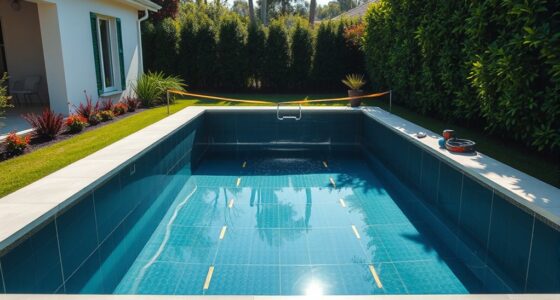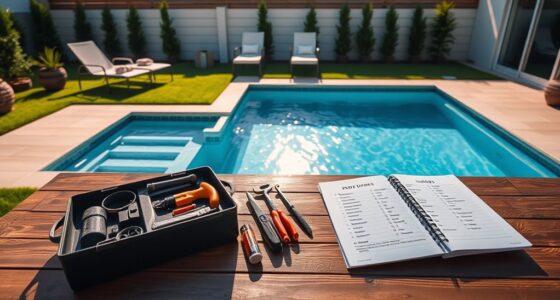To keep your endless pool easy to maintain, check the water surface daily and monitor water levels. Test water chemistry weekly, adjusting pH, chlorine, and alkalinity for clarity and safety. Inspect equipment monthly for leaks or noise, cleaning filters as needed. Perform seasonal deep cleans and troubleshoot issues like cloudy water promptly. Staying proactive with routine care can save you money and extend your pool’s lifespan. If you want detailed tips, keep exploring for expert advice.
Key Takeaways
- Perform daily water surface skimming and monitor water levels to prevent equipment damage.
- Test and balance water chemistry weekly, focusing on pH, chlorine, alkalinity, and CYA levels.
- Inspect and clean filters monthly to maintain water clarity and extend equipment lifespan.
- Conduct seasonal deep cleaning of the pool and troubleshoot issues like cloudy water or algae.
- Know when to call a professional for persistent problems or complex repairs to ensure safe, efficient operation.
Daily Checks for Cleanliness and Water Level

To keep your pool in top condition, you should check its cleanliness and water level daily. Start by skimming the surface to remove leaves, insects, and debris before they sink. Use a pool net or skimmer for quick removal to prevent dirt from settling on the bottom or clogging the filter. Next, inspect the water level—it should be about halfway up the skimmer opening. If it’s too low, add water to ensure proper circulation and prevent equipment damage. If it’s too high, water might overflow or dilute chemicals. Regularly monitoring these aspects helps maintain a healthy swimming environment and reduces the chances of costly repairs. Making these simple checks part of your daily routine keeps your pool inviting and in excellent condition. Additionally, keeping an eye on water chemistry ensures the balance of pH and sanitizer levels for optimal water quality.
Weekly Water Testing and Chemical Balancing
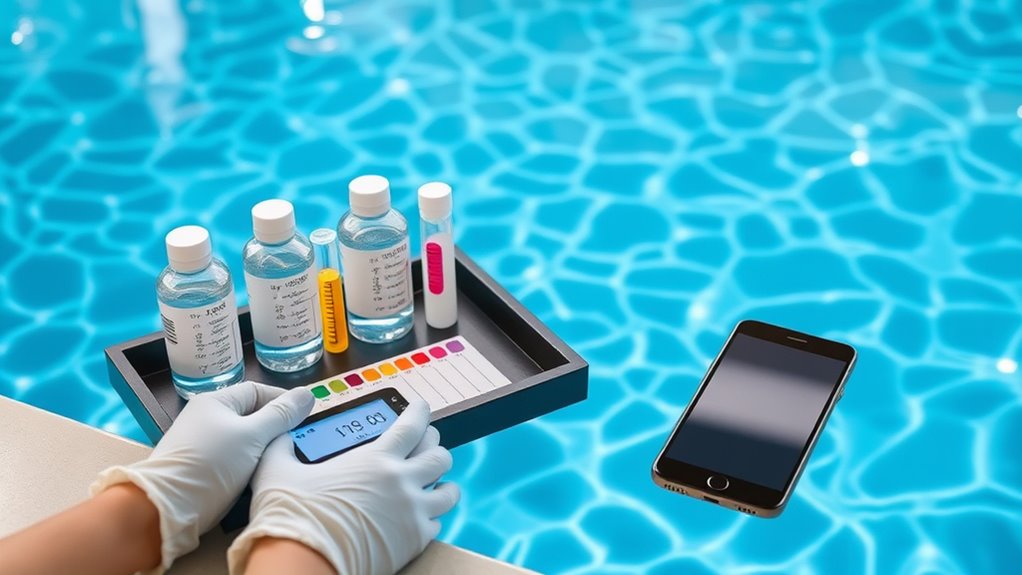
After verifying your pool’s surface is clear and water level is correct, it’s time to focus on maintaining balanced chemical levels. Regular testing keeps your endless pool safe and inviting. Use test strips or a liquid test kit to check the following:
Ensure your pool stays safe and inviting by regularly testing pH, chlorine, and alkalinity levels.
- pH level: Keep it between 7.2 and 7.6 to prevent irritation and equipment damage.
- Chlorine level: Maintain 1-3 ppm to effectively disinfect without overdoing it.
- Total Alkalinity: Aim for 80-120 ppm to stabilize pH and prevent fluctuations.
Proper chemical balancing also involves understanding the different testing methods, such as test strip accuracy versus liquid testing kits, to ensure reliable results. Adjust chemicals as needed to stay within these ranges. Proper balancing reduces algae, cloudiness, and algae growth. Consistent testing ensures your pool remains clean, safe, and enjoyable all season long.
Monthly Equipment Inspection and Maintenance

Each month, you should check that all your equipment is working properly to prevent issues. Take time to clean and inspect your filters to make sure they’re free of debris and functioning efficiently. Regular maintenance now saves you from costly repairs later. Additionally, staying informed about AI safety measures can help you implement smarter maintenance practices.
Check Equipment Functionality
Regularly inspecting your pool equipment guarantees everything operates smoothly and prevents costly repairs. During your monthly check, focus on ensuring all components function properly. Here are three key areas to review:
- Pump Operation: Listen for unusual noises and check for leaks or vibrations that could signal problems.
- Heater Functionality: Confirm the heater heats evenly and responds correctly to temperature adjustments.
- Control Panels: Test all control panel buttons and indicators to ensure they’re responsive and accurate.
If you notice any irregularities, address them immediately to avoid bigger issues later. Regular checks help catch small problems early, extend equipment lifespan, and keep your pool running efficiently. Staying aware of contrast ratio and other technical specifications can help you make informed maintenance decisions. Stay proactive, and your endless pool will reward you with hassle-free enjoyment.
Clean and Inspect Filters
Cleaning and inspecting your pool filters is essential for maintaining ideal water flow and clarity. Regularly check your filters to ensure they’re free of debris and buildup, which can restrict flow and reduce filtration efficiency. Remove the filter cartridges or elements according to your filter’s instructions. Rinse them thoroughly with a hose, using a brush if needed, to remove dirt and oils. While cleaning, inspect for tears, cracks, or damage that might compromise filtration. If you notice any issues, replace the filter promptly. Keep a record of your inspections and cleanings to track maintenance intervals. Properly maintained filters help keep your pool water clean, clear, and safe for swimming while also prolonging the lifespan of your equipment. Regular maintenance also prevents ineffective purification, ensuring your pool remains a healthy environment.
Seasonal Deep Cleaning and Inspection
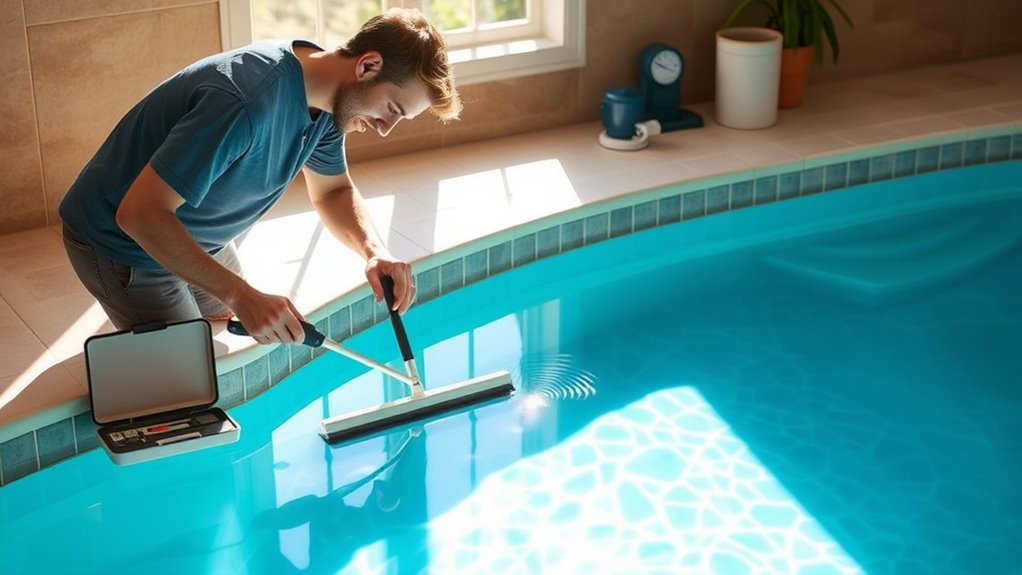
As the swimming season winds down, now is the perfect time to perform a thorough deep cleaning and inspection of your pool. This helps prevent issues during the off-season and guarantees your pool stays in top shape. Start by draining any remaining water and removing debris from the pool floor and walls. Then, check for signs of wear, cracks, or algae buildup. Incorporating proper maintenance routines can extend the lifespan of your pool components and ensure continued enjoyment. Here are three key tasks to focus on:
Now is the ideal time for pool deep cleaning and inspection before the off-season.
- Scrub the pool surfaces thoroughly to remove dirt and algae.
- Clean and inspect the skimmer, return jets, and drain covers.
- Check the pool’s equipment, including pumps and filters, for damage or leaks.
Completing these steps keeps your pool pristine and ready for the next season.
Troubleshooting Common Pool Issues

When pool problems arise, quick identification and resolution are essential to maintain clear, balanced water and safe operation. Common issues include cloudy water, algae growth, and equipment malfunctions. To troubleshoot effectively, recognize symptoms early. Use this table to guide your actions:
| Issue | Possible Cause |
|---|---|
| Cloudy water | Poor filtration or high bather load |
| Algae growth | Insufficient sanitizer or poor circulation |
| Equipment failure | Dirty filters or malfunctioning pump |
Start by testing water chemistry and inspecting equipment. Adjust chemical levels, clean filters, or repair parts as needed. Staying proactive prevents minor problems from escalating, ensuring your pool remains inviting and safe for use. Incorporating predictive analytics can also help anticipate potential issues before they occur, further simplifying pool maintenance.
Tips for Long-Term Pool Care
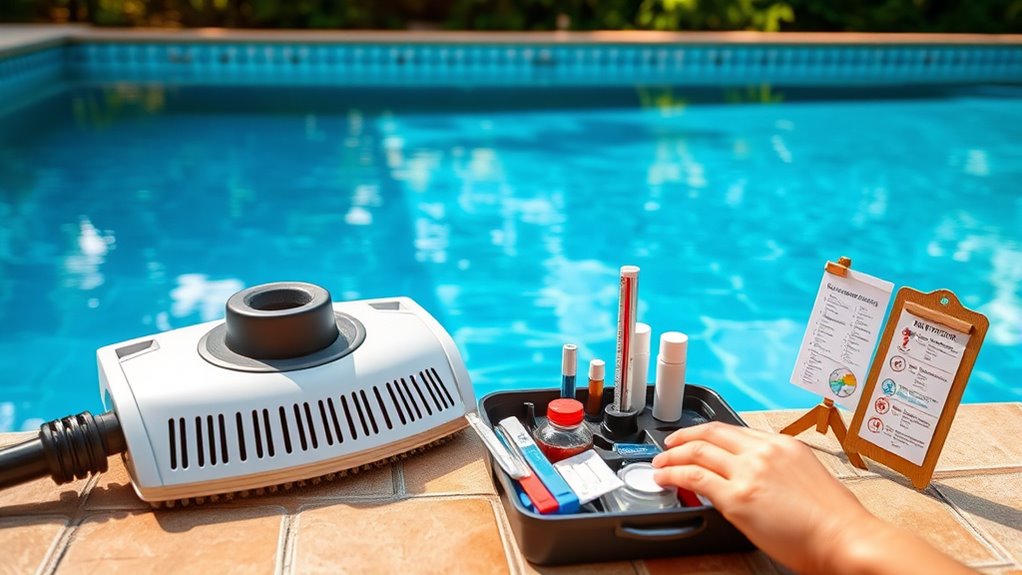
To keep your pool in great shape over time, you should regularly test the water to guarantee proper chemical balance. Maintaining your equipment, like filters and pumps, is essential to prevent issues before they start. Consistently focusing on these areas helps you enjoy a clean, safe pool year-round. Additionally, inspecting your air purifier filters and adhering to recommended maintenance schedules can further improve your pool environment by reducing airborne contaminants around your space.
Regular Water Testing
Have you checked your pool water today? Regular testing is key to maintaining clean, safe water. By staying on top of water quality, you prevent issues before they start. Here are three essential tips:
- Test pH and alkalinity weekly to ensure balanced water, preventing corrosion or scale buildup.
- Check sanitizer levels regularly, aiming for proper chlorine or bromine levels to keep bacteria at bay.
- Monitor stabilizer (CYA) levels to avoid overuse, which can hinder sanitizer effectiveness.
Use a reliable test kit or strips for accurate results. Record your measurements to track trends over time. Consistent testing helps you catch problems early, saving time and money while keeping your endless pool crystal clear and inviting.
Proper Equipment Maintenance
Regularly inspecting and maintaining your pool equipment is essential for guaranteeing its longevity and ideal performance. Check your pump, filter, and heater regularly for leaks, corrosion, or debris buildup. Clean or replace filter cartridges as needed to keep water flow optimal. Ensure the pump is running smoothly without unusual noises, which could indicate issues. Lubricate O-rings and seals to prevent leaks and wear. Keep an eye on your chemical feeders and automatic systems to confirm they’re functioning correctly. If you notice any irregularities, address them promptly to avoid bigger problems down the line. Proper equipment maintenance saves you money, prolongs equipment life, and keeps your pool running efficiently. Staying proactive with these small tasks makes pool ownership much easier and more enjoyable.
When to Call a Professional for Help
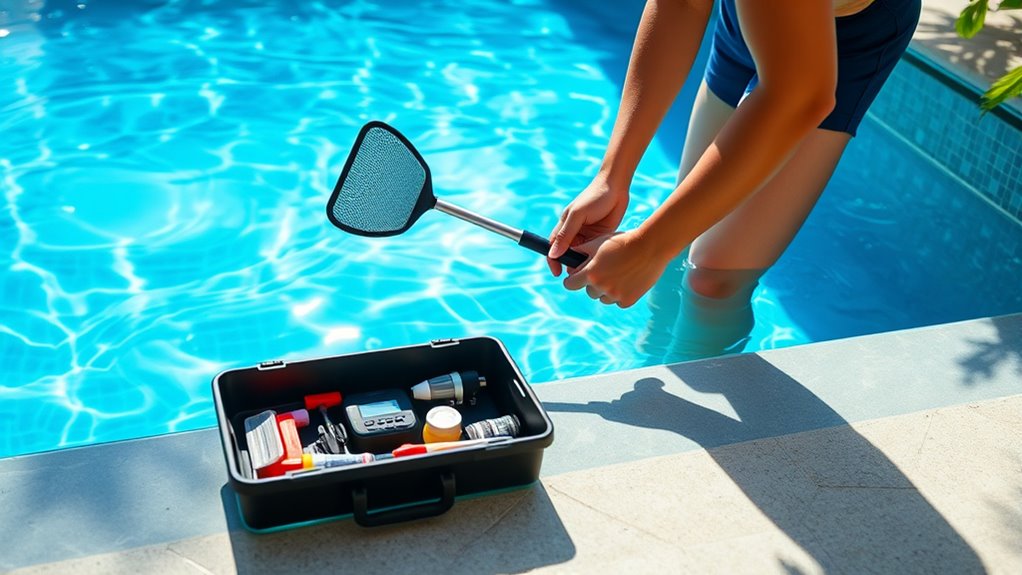
Knowing when to call a professional can save you time, money, and frustration. If you notice persistent issues that you can’t fix easily, it’s time to seek expert help. For example:
- Your pool has persistent cloudiness despite regular cleaning and chemical adjustments.
- You experience recurring equipment failures or strange noises from the pump or filter system.
- You’re unsure about handling complex repairs or electrical problems safely.
- Understanding industry trends can help you anticipate when professional maintenance is necessary, preventing larger problems down the line.
Attempting to fix these issues yourself can sometimes cause more damage or pose safety risks. If you’re overwhelmed or unsure about any problem, reaching out to a professional guarantees proper repairs and maintenance. Don’t hesitate to consult an expert when things seem beyond your control—it’s the best way to keep your pool safe, clean, and running smoothly.
Frequently Asked Questions
How Often Should I Replace the Pool Filter?
You should replace your pool filter every 1 to 2 years, depending on usage and water conditions. Regularly clean the filter every 1 to 2 months to maintain peak performance. If you notice decreased water flow or cloudy water despite cleaning, it’s time for a replacement. Proper maintenance ensures your pool stays clean and safe, so stay vigilant and follow your manufacturer’s recommendations for the best results.
What Are Signs of Algae Growth in My Pool?
Algae creeping into your pool is like weeds invading a garden. Look for a slimy or fuzzy film on the water surface or walls, which signals algae growth. You might also notice a sudden green tint or cloudy water that doesn’t clear up with filtration. If you see these signs, it’s time to shock your pool with chlorine, brush the surfaces, and run your filter longer to keep algae at bay.
Can I Use Household Chemicals to Balance Pool Water?
You shouldn’t use household chemicals to balance your pool water. These products aren’t formulated for pools and can upset the chemical balance, potentially causing damage or health issues. Instead, use chemicals specifically designed for pool maintenance, such as pH adjusters, chlorine, and algaecides. Follow the manufacturer’s instructions carefully to keep your pool safe, clean, and properly balanced. This guarantees your pool stays inviting and healthy for swimming.
How Do I Winterize My Endless Pool?
Winterizing your endless pool is like preparing a ship for a long voyage. First, lower the water level below the skimmer, then drain the pump, heater, and filter. Add antifreeze to prevent freezing damage, and cover the pool securely. Disconnect and store the accessories. Regularly check the cover and equipment during winter. This way, you safeguard your pool and ensure it stays in top shape for spring.
Is It Safe to Swim Immediately After Chemical Adjustment?
It’s generally safe to swim immediately after adding chemicals, but you should wait until the chemicals are fully dissolved and the water temperature stabilizes. Test the water with a reliable kit to guarantee proper pH, chlorine, and other levels before jumping in. If levels are within the recommended range, it’s safe to swim. Always follow your pool’s specific instructions and wait a few minutes after chemical adjustments for ideal safety.
Conclusion
Just like a well-tuned orchestra, your pool runs smoothly when you stay on top of regular maintenance. By keeping up with daily, weekly, and seasonal tasks, you’ll enjoy endless hours of crystal-clear water and hassle-free swimming. Remember, even the most beautiful symphony needs a skilled conductor—so don’t hesitate to call in a pro when things get tricky. With a little care, your endless pool remains a invigorating oasis all year round.


